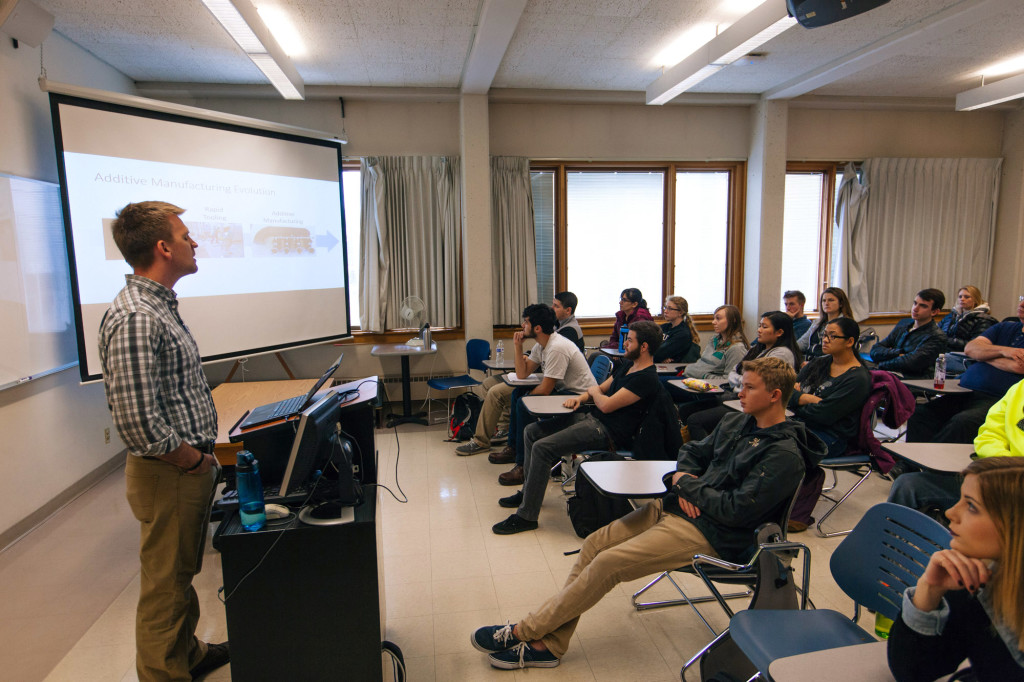The promising future of 3D printing is expanding, and soon this technology will be more available at Seattle University. The Department of Mechanical Engineering held a seminar on Nov. 12 to discuss the basics of additive manufacturing and future plans to create a 3D printing lab at Seattle U.
Led by Assistant Professor from the Mechanical Engineering Department Josh Hamel, the seminar gave an overview of the past, present and future of 3D printing, and differing techniques used.
“This [3D printing] is something that I want to know more about,” Hamel said. “Getting students involved and feeding off the energy that many of you students have is a great way to learn about this together.”
Of the many types of manufacturing, two are primarily used in the industry. Traditional subtractive manufacturing begins with a stock piece of material that is subsequently milled, machined and shaped into the final part in processes that are often very time consuming. Additive manufacturing is given its name because of its processes of building, casting or adding material; which, depending upon the chosen material, is often fast and cheap—perfect for a prototype.
Students are excited by the possibility of more 3D printers on campus and exposure to the relatively new type of manufacturing.
“I came today because I want to be involved in 3D printing,” said junior mechanical engineering major DJ Traina.
3D printing falls under the category of additive manufacturing, as prototypes and pieces are built from the ground—or rather workspace—up. The way these “printers” build parts is on a printer-to-printer basis. Most marketed printers; however, extrude plastic in successive layers and in different shapes ultimately resulting in a finished, semi-precise part. Depending upon the technology, some 3D printers are able to create finished products rather than just prototypes.
The origins of 3D printing technologies are older than one might think. Additive manufacturing was first used in rapid prototyping (RP) in the 1980s and 1990s, and allowed manufacturers to test systems and designs before producing a finished product. Over the years, the technology has become faster and the materials and equipment have become cheaper.
Attendants at the event were excited to learn about this innovative form of manufacturing and how it will be brought to campus for them to learn from.
“I don’t know much about [3D printing] other than it can be a more efficient way to make something. I want to see how it can be used,” freshman Levon Markossian said.
Junior Jonathon Robbins echoed this sentiment of wanting to learn more about the process of using a 3D printer.
“I have a very limited understanding about [3D printing] and I want to expand that,” said Robbins.
After introducing his audience to the current available technologies, Hamel discussed the challenges of 3D printing. He emphasized that there is a lack of knowledge about the process because the education is so limited.
“The biggest problem that companies that are trying to use this manufacturing have is that none of their engineers know how to use 3D printing,” Hamel said. “The technology is better than our ability to use it. [Students] are not being taught how to do this because [professors] do not know how to do it.”
While there is a lack of education, Hamel felt that there is an opportunity to better educate students about 3D printing through experimentation of plastic material, geometry, settings of the printer and to then look at the effects. In order to do this, he revealed his plans to create a 3D printing area on campus.
“We are going to try to set up a student design shop,” Hamel said. “We want to set up some computers and printers in there and this could be our place to play and experiment with 3D printers and see what they can do. The more we play with these printers, the more questions we will come up with and answers we will find.”
Hamel also hopes to start a RepRap Club on campus. Short for Replicating Rapid Prototyper, RepRap aims to build a 3D printer that has the ability to print itself. This RepRap club would allow students to experiment with 3D printers and possibly create one themselves to use.
Mechanical engineering students were eager to see the printers implemented and to be able to learn from them.
While the placement of these printers is still unsure, Hamel hopes to get them installed before spring break.
Editor may be reached at [email protected]













